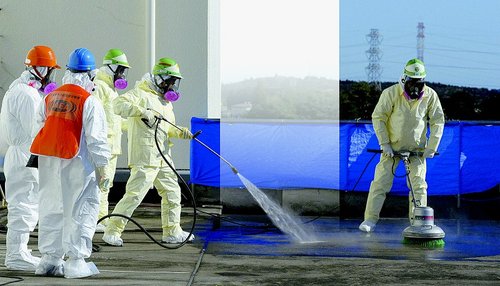TEPCO might dump radioactive water into Pacific
 0 Comment(s)
0 Comment(s) Print
Print E-mail
Xinhua, December 9, 2011
E-mail
Xinhua, December 9, 2011
The operator of Japan's crippled Fukushima No. 1 nuclear power plant has said it is considering dumping radioactive water into the Pacific Ocean as it is running out of space to store the radioactive waste.
|
|
|
Japan's quake damaged nuclear power plant leaked about 45 tons of highly radioactive water and some may have drained into the Pacific Ocean, its operator confirmed on Dec. 5. [Photo: QQ.com] |
Tokyo Electric Power Co., also known as TEPCO, said Thursday that the plant was likely to reach its maximum storage capacity of 155,000 tons by around March next year due to massive inflows of groundwater and as such was mulling the idea of once again releasing radioactive water into the sea.
"We would like to increase the number of tanks to accommodate the water but it will be difficult to do so indefinitely," Junichi Matsumoto, a spokesperson for TEPCO, told a news conference.
Matsumoto explained that between 200 and 500 tons of groundwater flows into the reactor turbine buildings on a daily basis and the volume of water being processed is more than that required to be injected into the reactors.
"We cannot keep on increasing the number of tanks in the next year or two. So we're considering the possibility of releasing water into the sea,'' Matsumoto said.
TEPCO said it would conduct a detailed environmental assessment and submit it to the government with the aim of discharging only contaminants that would have the least effect on the environment.
But while the processing facility at the plant effectively reduces levels of cesium in the water, concentrations of radioactive strontium, which causes leukemia and bone cancer in humans, is not effectively dealt with, leading scientists have proffered.
The move has been met with outrage by environmental groups, scientific communities and anti-nuclear lobbies.
The National Federation of Fisheries Cooperative Associations lodged an official complain with the utility firm and the Economy, Trade and Industry Ministry Thursday, saying that the federation remained staunchly opposed to the plan and under no circumstances could accept such a proposal.
The federation warned that Japan's fishing industry could be severely affected by vastly lowered consumption rates as the public would fear the potentially devastating effects of exposure to radioactive strontium.
"We will never allow you to pour the dangerous water into ocean so easily." Ikuhiro Hattori, told TEPCO chief Toshio Nishizawa. He went on to tell the president of the embattled utility company that he has already asked Tadahiro Matsushita, senior vice minister for economy, trade and industry, which oversees the nuclear industry, to reconsider the plan and will work on relevant parties to prevent them from implementing it.
In addition, Nobutaka Tsutsui, senior vice minister for agriculture, forestry and fisheries, said at a press conference that he also absolutely could not approve the plan.
TEPCO has already released tens of thousands of tons of contaminated water into the Pacific Ocean following the March disaster at the facility, which was crippled by a massive earthquake and ensuing tsunami, subsequently sparking the world's worst nuclear disaster since Chernobyl.
Compounding safety fears at the nuclear facility located 240 km north of Tokyo, which is supposed to be brought to a state known as cold shutdown by the end of the year, TEPCO confirmed that radioactive water from the plant freely leaked into the Pacific Ocean on Monday.
Officials said that around 45 tons of water contaminated with radioactive substances cesium and iodine had likely run into the ocean from a gutter system into which water had leaked from a condensation unit.
Matsumoto said the leaked water contained 16,000 becquerels per liter of radioactive cesium 134 and 29,000 becquerels of cesium 137, surpassing government safety limits by 267 and 322 times respectively.
Local media reports also said that the contaminated water likely contained strontium.
The radioactive water leaked from a desalination unit and through a crack in a concrete wall and into a gutter. The gutter connects with a drain that flows freely into the Pacific Ocean, the utility said.
The utility also said that sand bags were being used as an emergency means to prevent further leakage from the unit, but that it could take up to three weeks until the exact amount of leaked radioactive water was known.






